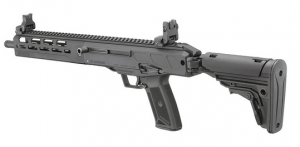The article quoted below offers a brief history of both rounds and good detail on both rounds. The 5.7x28mm has my attention. I want a Ruger 5.7x28mm LC Carbine. Not only that, but the low recoil round has an appeal all its own for smaller women or perhaps men with arthritis. Also ran across this Paul Harrell FN 57 vs. the Meat Target video, in which he provides some background before shooting. And, some handloading of 5.7x28mm info is here and here.
The introduction of the Ruger 57 sparked renewed interest in the 5.7x28mm round. FN created 5.7mm to be a defensive round for the military, primarily for pistols and smaller personal defensive weapons. This, coincidentally, is almost the exact same niche filled by the 9x19mm cartridge, one of most-popular rounds on the market today. So what (if any) are the advantages of 5.7 vs 9mm?
[…]
Advantages of 9mm
Almost universal acceptance and a 70 year head start on 5.7 has made 9mm one of the most commonly available calibers today. Ammunition manufacturers around the world make a dizzying variety of 9mm ammunition. There are also 9mm pistols in every corner of the world, in every shape and size.
Because of this popularity, 9mm is cheap compared to other centerfire pistol rounds. There are usually many different kinds of ammo available at any given moment.
9mm is also an effective defensive round. Bullet technology has improved to where 9mm hollow point ammunition enjoys a proven track record. Millions of gun owners trust it around the world.
Advantages of 5.7mm
The big advantage is speed, and lots of it. The 5.7mm round uses lighter weight bullets than a round of 9mm. Rather than shoot a 115 grain 9mm round at around 1100 FPS, the 5.7mm fires 40 grain rounds that scoot out of the barrel at around 2300 feet per second.
FN designed 5.7mm rounds with a ballistic profile that is more similar to a rifle bullet than a pistol bullet. A 5.7mm has a pointed tip and boat-shaped tail which help it cleave through the air, increasing its effective range.
The diameter of 5.7 vs 9mm makes a difference inside the pistol. A round of 5.7mm is less than 2/3rds the diameter of a round of 9mm. This means you can stack more of them inside a magazine. This in turn means more rounds inside the magazine of your pistol.
Disadvantages of 9mm
9mm is not a round designed for longer distances. The shape of the nose is round, and the bullet looks a bit squat when viewed in profile. This is not a shape that is optimized for long-range shooting. For that reason, we use most long guns chambered in 9mm in close quarters combat, not at longer ranges.
Disadvantages of 5.7mm
5.7mm is the new kid on the block. Because of this, there is not the wide variety of ammunition available for it compared to 9mm. In addition, the best ammunition for it, the SS190 armor-piercing round, is not available for sale to armed citizens. The SS190 is considered to be “armor-piercing,” and that’s a no-go for armed citizens, says the ATF. On top of this, the cost per round of 5.7 vs 9mm is higher by about 10%, which translates into less bang for your buck (literally).
The Bill of Rights is a bill of goes and no-goes, according to the ATF.
9mm Fiocchi 115 Grain Full Metal Jacket
Average muzzle velocity: 1132 fps
Average muzzle energy: 327 fps
9mm Sig Sauer 124 Grain Jacketed Hollow Point
Average muzzle velocity: 1151 fps
Average muzzle energy: 365 ft/lbs
5.7mm FN 30 Grain SS195LF Jacketed Hollow Point
Average muzzle velocity: 2162 fps
Average muzzle energy: 311 ft/lbs
5.7mm American Eagle 40 Grain Full Metal Jacket
Average muzzle velocity: 1653 fps
Average muzzle energy: 243 ft/lbs
The velocity of a 5.7mm round might be much higher than a 9mm round. However, the lighter weight of the bullet means that it doesn’t deliver the same amount of energy on-target that a round of 9mm does.
There are gel tests and more at the link.




